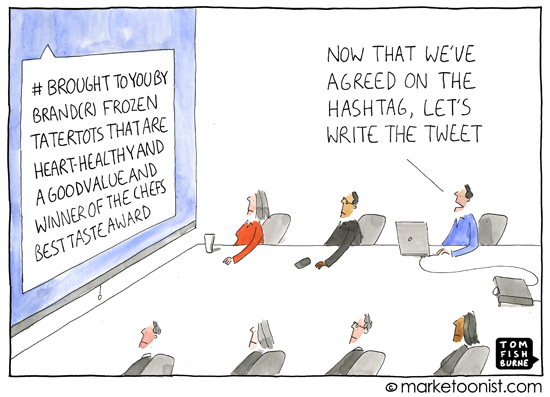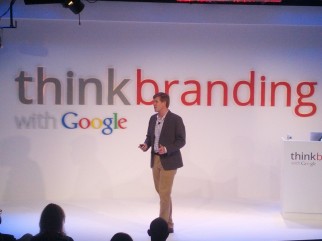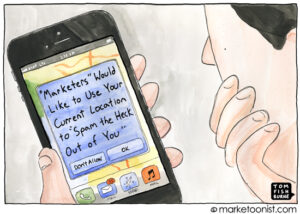Last week, I gave the keynote at Google’s marketing conference in New York (which you can read as a cartoon-filled post here). I spoke about how to create “marketing worth sharing” and that technology can’t save a boring idea.
One of the bigger themes of the day was the shift needed in how marketers tell stories. Many of us were trained in the Single Minded Proposition school of marketing, where you succinctly repeat what your brand stands for in every brand communication: “Volvo equals safety”, “Volvo equals safety”, “Volvo equals safety”.
In today’s two-way conversational world with brands and consumers, brand communication is more complicated. We need a variety of messages, and we can’t script every interaction. If we only remind consumers that “Volvo equals safety”, they will quickly tune us out. Rather than cram our SMP into every communication, we need a variety of things to say. Our brands need editorial calendars more than slogans.
This also means that we need to relinquish some of the control in brand communication. When your main brand communication was a single expensive 30-second spot, it made sense that everyone on the extended brand team scrutinized the creative. Now that brands are continuously publishing, the same command-and-control model doesn’t scale. It also doesn’t scale now that much of the communication is generated by consumers.
This communication shift requires a mindset change. In my Google talk, I shared five aspects of this mindset change. I’d love to hear your thoughts on it.
(Marketoonist Monday: I’m giving away one signed print of this week’s cartoon. Just share an insightful comment to this week’s post by 5:00 PST on Monday. I’ll pick one comment. Thanks!)



Pontus says
Tom,
Great post, you’re hitting the nail on the head again. You capture the problem of corporate “we have to get all our messages in there” + “everybody has to have their say” mentality perfectly. I recognize this far too well from a number of companies I’ve worked with. The solution seems obvious, focus on a few strong messages and have the courage to realize that you don’t have to do everything by committee. But it’s difficult to make this happen.
Thanks, Pontus
Tessa says
Great post and cartoon, Tom, and I have read and tweeted your Google talk.
Pontus has absolutely identified the problem. It’s very hard for companies to move from a command and control messages position to a looser, more informal stance. Especially when everyone in a company has a view on marketing, and if the senior guys are in their 50’s, a very particuar type of marketing.
Dani says
The communication shift requires indeed a mindset change and one of my favorite points of your article is brands losing part of their control over their communication, with the rise of social media and with much of it being generated by the consumers themselves.
It’s impossible to control where your brand goes. Your brand starts being dispersed, your brand starts being part of the conversation out there. And I think marketers should not fight this but they should embrace it and find ways of working with it.
Thanks,
Dani
Tom says
I think one of the biggest
It’s two aspects: one is the must use shiny, new technology because shiny new technology = relevance = sales aspect (one bit of research I’d like to see is how are tweets driving sales?). Everyone likes the new item, but just because it is new doesn’t mean it is effective.
Second is the idea that consumers care about what we have to say just because they’re following us. This reminds me of the rise of the internet all over again. Everyone who was anyone had to have a website (think Jack Welch’s division website that even had recipes on it that he mentioned in his book). But eventually people realized that nobody was coming. People can only manage about 100-150 relationships and just having a website or having a large amount of follows doesn’t equal brand loyalty or sales. Just because you “follow” a brand, doesn’t mean you’re paying attention to it.
Michael says
I love the hashtag joke – I’ve actually attended meetings like that …
Giving up control reminded me on a Cyberlion winner from Cannes this year, the Curators of Sweden campaign with their shared Twitter account. Wouldn’t it be cool having a consumer running a brand’s Twitter account for a day or a week?
GaryK says
Good one, Tom.
It seems today’s marketing isn’t about a One Big Bang idea anymore, it’s about a steady streams of smaller, interrelated Booms.
Pontus says
Tom,
Completely agree on your two aspects. The shiny new toy/technology thing seems to be in no small part powered by a fear of being left behind, or that the competition will get it before you do. But of course “Being first” is a lot less interesting than “Being relevant”. And customers pick that up very quickly.
On your second point, consumers (and decision makers in B2B) cares about what is relevant to the, So your point about having a website or a social media presence without understanding what is relevant to your target audience is spot on, they will not pay any attention to it.
@euonymous says
Tom, while I respect your point, you have to admit that “Volvo equals safety” is a heck of a message to have embedded in the marketplace. It has value. When messages get too complex, they become diffuse and lose impact. Much like the hashtag in your cartoon. I like to think that we need clear positioning AND to be open to any conversation that pops up. Positioning may be different for different markets, so targeted marketing may come in different flavors.
Pontus says
@Michael – that’s a great idea, having a consumer run a brand’s twitter for a week. If nothing else it would certainly provide a lot of insights into what is important to consumers.
@Tessa – good point about everyone having a view on marketing and very specific view if you belong to a certain demographic.
Lisa Richardson Waller says
Brands are somewhat like model homes. Photos in frames show me who you think fits in the house. The absence of them lets me imagine I do.
Ryan says
Rather than Single Minded Propositions, perhaps our brands need Single Minded Purposes.
In the post 30″ spot era, repeating the same single minded proposition over and over across all consumer touch points sounds like a good way to bore your audience.
I think that strong brands today are like inspirational people. Inspirational people are certainly not limited to only one conversation. Instead, they are multidimensional and have many rich, engaging stories to tell. That said, all their stories and behaviors are united by one fundamental element: a purpose. Strong brands are no longer driven by a single minded proposition, rather, they are driven by a single minded purpose. They have a clear understanding not only of what they do and how they do it, they know exactly “why” they do what they do. Moreover, they successfully communicate their purpose to their audience and this becomes the emotional glue that drives brand loyalty.
Allen Roberts says
Tom,
Lovely, one of your best!!
Allen
Trainer Giselle says
Tom,
Marketing is only a tiny part of the role I play for my company, but I fully intend to take the training part of my job and use your message to the selling team. Just as marketing can not hammer home all points at once, sales can not either. For them to be effective without sounding like a “pitch man” they need to tell a story to the person they are sitting with in that moment. Our brand message in their selling hands needs to be simple, clear and relevant to the listener.
Sandra Pickering @opento says
Lovely cartoon – and true.
Lisa Richardson Waller makes a good comparison with model homes but, intentionally or not, every brand creates a ‘model home’ that shouts out who is invited and welcome and who isn’t. That’s the psychology of brands.
I think I’ll start a campaign to stand up for marketers. They are constantly berated for getting it wrong, not being up-to-date, sticking to old ‘laws’ or not even having laws and just using ‘judgement’ for Pete’s sake 🙂
It’s time to defend marketing folk – they are often the only part of the company focusing on growth and …. some of my best friends are marketers!
tomfishburne says
Hi all,
Really fascinating conversation. Many thanks for looking at this from so many angles.
I love the Curators of Sweden example, Michael. What a brilliant case study: http://curatorsofsweden.com/about/
This week’s signed print goes to Ryan. I love the idea of the Single Minded Purpose and the insight around strong brands as inspirational, multidimensional people.
Best,
-Tom